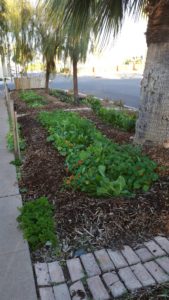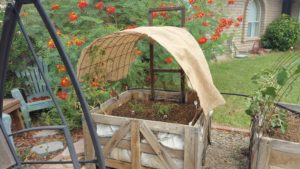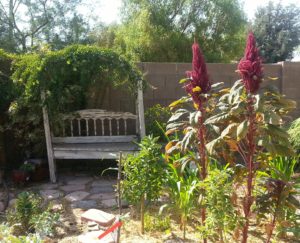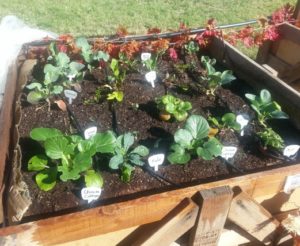Water Wise Gardening Tips
Gardening in Phoenix, Arizona is challenging, particularly in May and June when the temperatures soar and rainfall is rare. In order to properly water our plants, we employ Permaculture strategies for water wise gardening. These strategies conserve our precious water resources while providing the moisture that our gardens need to survive the low desert summer. Whenever we can, we apply low-cost solutions and use recycled materials in an effort to be green and thrifty. Many of these water wise gardening strategies serve more than one purpose, reducing water usage, improving our garden soil, protecting our plants and saving us money on our utility bill, too. Here are some tips that you can use, too!
 Instructions:
Instructions:
1. Mulch, mulch, mulch!
Covering the soil with several inches of organic materials keeps the soil temperature cooler and holds moisture in the soil. We pile on a very thick layer of straw, hay, compost, grass clippings, wood chips, or whatever materials we have available. As the organic material breaks down, it feeds the soil microbes and earthworms, and replenishes soil nutrients.
2. Compost happens.
On the farm, we have lots of waste materials from our livestock pens, chicken coops and vegetation. What we don’t use for mulch gets composted. When the compost is broken down, we spread it on top of the soil or lightly till it in. The organic matter helps to hold moisture in the soil like a sponge.
 3. Let it grow!
3. Let it grow!
Sometimes seeds survive the composting process, and when we spread the composted materials around our property, we get volunteer plants. The watermelon in this photo grew of its own accord in our lawn. Since we were already watering the grass, we postponed mowing and let the watermelon stay. It turned out to be one of the best watermelon plants we have ever had, and cost us no extra water. In case you are wondering why we even have a lawn in Phoenix, it keeps our backyard temperatures and dust down, and feeds some of our livestock.
4. Water from below.
Some of our garden beds are watered from the bottom, wicking up moisture from below. This growing method greatly reduces evaporation, and we rarely have to refill the tanks. find out more about wicking bed gardens, go here.
 5. Make some shade.
5. Make some shade.
In areas of the garden that don’t have nearby trees or other sources of natural shade, we provide some help. Using layers of garden tulle or shade cloth, the soil is shaded while still allowing enough sunlight to produce tasty veggies. Draped all the way to the ground, it also reduces temperatures and protects plants from pests. Keep in mind that bees cannot get to vegetable flowers that are draped to the ground, so you will have to roll back the covers in the mornings when bees are active or hand pollinate.
 6. Go native.
6. Go native.
Growing native varieties that are well adapted to the climate requires less water than growing tender varieties that originated in wetter climates.
7. Create your own plant varieties.
By saving and growing seeds from the hardiest plants in our garden, we are creating plant varieties that are well adapted to our climate and the unique growing conditions on our farm. For more information about developing your own plant varieties, go here.
 8. Use water twice.
8. Use water twice.
Every time we wash a load of laundry, one of three zones in our garden gets watered. Using a laundry-to-landscape system, wash and rinse water is diverted from the sewer to our orchard and perennial vegetable plants. For more info from Art Ludwig, inventor of the laundry-to-landscape system, go here or here.
9. Plant in close quarters.
Plant vegetables and flowers together densely to serve as a living mulch, shading and protecting the soil. The plants will also help to shade each other and keep the garden cooler. Inter-planting and companion planting has many additional benefits, as plants are able to feed each and provide defense against pests and diseases.
 10. Water deeply.
10. Water deeply.
Every time we water, we run the drip system long enough for the moisture to reach depths of 12 to 18 inches. This practice encourages plant roots to grow deep into the soil where more moisture is available to them. It also serves to bank water deep in the soil, reducing evaporation.
You can use a long screwdriver or soil probe to test for water depth. Run your irrigation and allow the moisture to soak into the soil for about half an hour. Then, press the end of the probe down into the soil slowly, feeling for a change in texture. In dense soils, the probe will become more difficult to penetrate once it reaches below the moisture line. In loose or sandy soils, you may feel slight resistance in the moist layer, followed by a release of tension once you reach dry dirt. If moisture has not reached a depth of 12 to 18 inches in your vegetable garden, run the water longer and test again until the proper depth is reached. Keep track of the time so that you can run the irrigation for that duration every time you water.
 11. Harvest water.
11. Harvest water.
It seldom rains in Phoenix, but when it does, we are ready to set out tubs and barrels to capture as much as we possibly can. Unlike rainwater, one source of water is very prevalent during the hot Arizona summers: air conditioning condensation water. We collect roughly 10 gallons per day of clean, cool water from our air conditioning unit, storing it in two barrels for use in our gardens. To find out how, go here.


